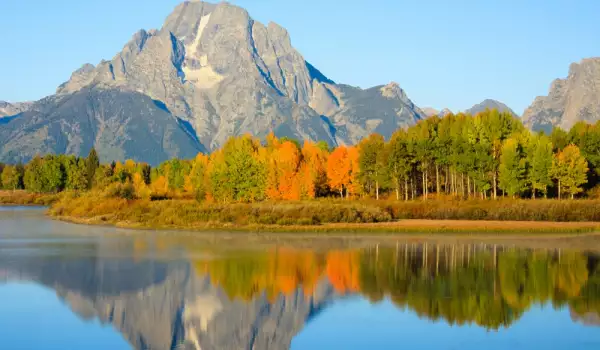Mount Moran

Mount Moran is a popular challenge for rock climbers and mountaineers in the U.S. Moran is located within the Grand Teton National Park in western Wyoming. The panorama of Moran stands against the Wyoming's Teton Range, the tip is formed in its northern part. Mount Moran reaches 1830 m altitude, and in its left foot holds the beautiful Jackson Lake.
This popular rock giant is named after Thomas Moran, a famous American artist who paints mostly landscapes of the West. The tip has an interesting structure - distinguished by its blunt tip with a black vertical stripe on its upper side and the top has a visible small marine sandstone cap.
Like the mountains in the middle of the chain, the face of Mount Moran is characterized by basalt formations known as the Black Dike. Against the rest of the mountain chain, Moran stands alone as the lone wolf of the northern entrance of the Grand Teton National Park. The story of the giant is marked by a dark date- November 21, 1950, when a cargo plane C-47 crashed into the mountain during a storm, killing all 21 passengers on board.
Rescuers reached the crash site on 25 November, but due to extreme location, it is impossible to move either the corpses, or the aircraft itself. Its remains lie in the same place on Moran today, but authorities have sealed off the mountain route to them.

By its nature and type- Mount Moran is a massive and impressive mountain that is a challenge for many climbers and mountaineers. However, the difficult transition to make it to the top makes this peak less preferred to other giants in the region. For more than 20 years hiking to Moran is unsupported, overgrown with wild vegetation and marshy areas along Leigh Lake.
Most climbers choose routes from the String Lake, followed by a transition of Leigh. Even though the technical climbing section of Moran is relatively short, the overall ascent to the summit takes several days. The first ascent of Mount Moran was made on 22 July 1922 by three climbers from the climbing Club of Chicago - LeGrand Hardy, Bennet McNulty and Ben C. Rich.
They reached the peak on the route known as Skillet Glacier, which today remains the most popular option for upward transition. During the ascent you pass through the snows of the glacier and special equipment is needed.
However, the most preferred route to the summit of Moran remains its eastern slope, south of the Black Rainbow. The route is known as the CMC route and offers good rock climbing without snow and ice. The southern slope of the Moran transition is marked by the Direct South Buttress, which remains a classic in mountain climbing.















